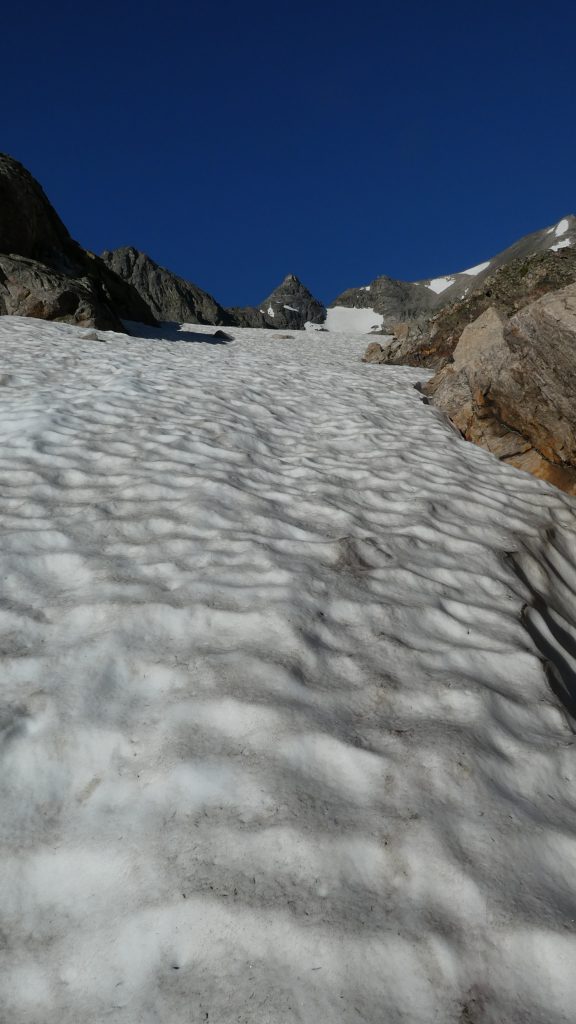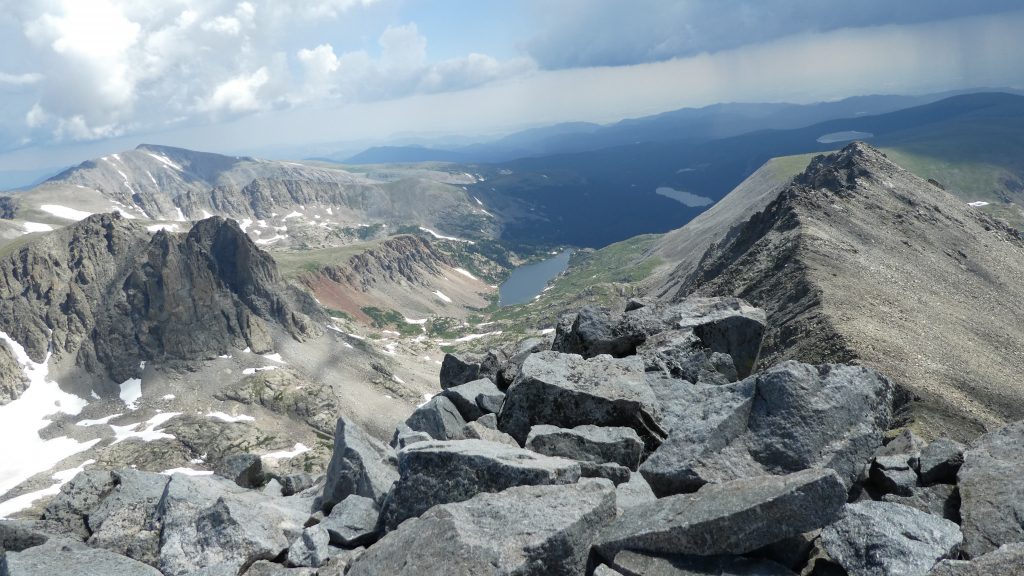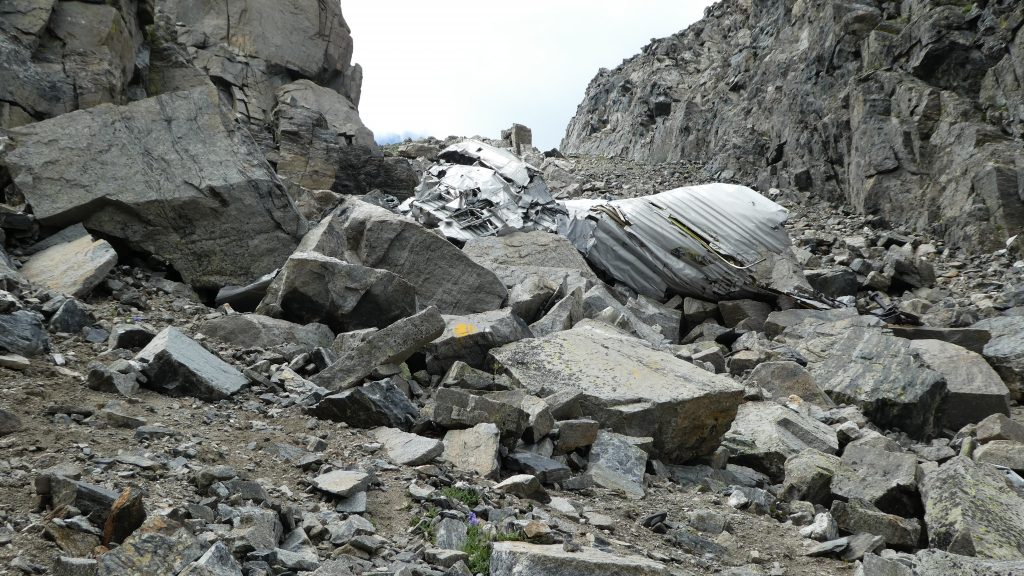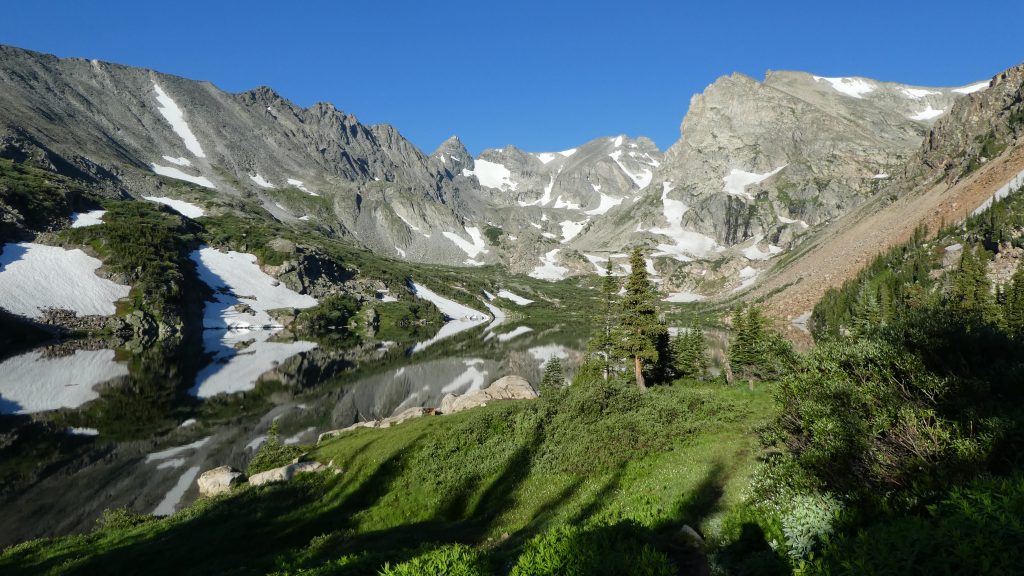





I awake way before dawn after a somewhat restless night, and start to prepare for the new days event. The plan is very exciting, but I am also a bit apprehensive about this somewhat serious adventure.
I don’t always climb alone, but the challenge of finding a compatible partner who is willing to awake before dawn can be somewhat challenging, and a bad partner is much worse than being alone. I thoroughly enjoy just being in the mountains and the solitude invigorates a meditative state that can approach nirvana. I am obviously much more cautious when I am alone, but this forethought elevates my mental attitude, and I become very in touch with the mountain environment that I truly love.
The route that I am hoping to climb is my favorite in the local area. The West Chimney of Navajo Peak involves a fairly long approach, some moderate snow climbing, and a somewhat challenging class 3+ chimney on a fairly remote mountain face.
I’ve climbed this route twice before, so I know what I’m getting into, but I’ve aged a bit since the last attempt, and know that it deserves respect.
I had made a feeble attempt about a week ago, but a sixth sense and less than perfect weather caused me to turn back early. The alternative was finding shelter from the harsh wind, and spending a lazy morning in an awesome and very secluded high alpine meadow. The meadow was above the extremely popular Isabelle Lake and offered complete solitude and a comfortable bed of soft grass. The wild flowers were in full bloom, and their sweet scent along with the gentle sound of a small raging stream lulled me to sleep in the warm sun.
I awoke refreshed and enjoyed a casual lunch while enjoying the vista of a now windy and cloudy summit. “I’m really glad that I’m not up there right now.” I thought to my self, as I finished basking in the warm sun.
But, today feels very different, and I’m anxious to finish the challenge. The weather looks perfect, and so are my energy and spirits, as I park my van at the trailhead. A note stating, “Climbing west Chimney of Navajo. Back by mid afternoon.” is left in a conspicuous location on my dash, and I’m on my way.
The dawn of the new day is starting to brighten the sky as I saunter briskly along the well worn trail to Isabelle lake. The path is lined with some gigantic Fir and Spruce trees that are much older than me and I stop to hug one of the more ancient ones. A pair of does and a young buck are grazing in an adjacent meadow, and a few birds are greeting the dawn, but they are not alarmed to see me.
The first rays of the early morning sun light up the high peaks as Navajo and Apache come into view, and my soul is suddenly invigorated.
A couple of early morning photographers and a young moose great me as I reach the stunning vista of Isabelle lake. But here the main trail ends, as I leave the soon to be busy valley and wander alone into the high alpine zone. The trail has suddenly disappeared, but a maze of grassy ledges and tiny valleys provide for a fairly easy scramble.
My awareness suddenly kicks in to my extreme mode, because I am aware that even a short stumble could result in a minor injury that could be fatal in this remote place.
I am carrying reasonable survival gear and a loud whistle, but the chance of being found rapidly on this remote mountain face are still slim, so I must be extra cautious. This caution forces a mental attitude that is totally focused and very enjoyable. All the cares of the world suddenly disappear as I wander upwards concentrating on the task at hand.
The air is a bit brisk, but the sun is warm, and the views are brilliant. The soft tundra is bursting with tiny plants that only have a few months to live, and they are fully utilizing every moment with great pleasure. The high peaks are still adorned with the remnants of the winter snow and it glistens brightly in the morning sun. But the snow is rapidly melting in the summer sun and has created dozens of clear sparkling streams. The tiny rivers cascade off of the cliffs of the steep walled valley, and the lush banks are adorned with dozens of colorful wild plants and flowers. The combination of the aroma, sound, and view of this pristine paradise awakens my inner senses and my old mind approaches nirvana.
The quickly receding old glacier has left about a hundred new yards of manky scree that involves a frustrating mixture of scrambling and sliding backwards, but I manage to find a reasonable route to the snow, and arrive a bit out of breath. But, my energy quickly recovers, as I stop for a quick snack and attach my crampons.
The next 500 feet or so of the climb involves kicking steps in some fairly firm and somewhat steep (40-45 degree) snow. This is actually about the easiest way to climb a mountain if you have the right skills and equipment, and I do. I have come prepared with one medium length ice axe, a “Whipit” (ski pole with a small ice axe), and crampons.
The steep snow allows for a rapid ascent, that is much more pleasant than the loose scree. But, kicking steps in the hard snow is quite strenuous, so I stop a few times to catch my breathe and ponder this awesome paradise. The rhythm of setting a fast pace seems to be more efficient, so I divide the slope into about 5 segments of sprint and rest, and each phase brings me ever closer to the summit.
The cool air feels fresh in my lungs and the blood rushing through my brain clears my mind as the last sprint brings me to the top of the snow. Here, the means of travel will change again and I stop on a comfortable rock to remove my crampons and pack away the ice axes.
The rest spot is warm and sunny, but the climate suddenly changes as I wander upward onto the shady west face. A brisk breeze is howling through the steep saddle between Navajo and Dicker’s Peck and the usually easy route has been coated with a bit of graupel from the last thunderstorm. These conditions are not quite what I had expected, but I know the route, the weather is good and don’t wish to turn back now.
I am now extremely aware of my remoteness and the harsh penalties of any mistakes. The normally 3rd class route is partially covered with a thin layer of frozen rain so I proceed with the utmost caution, and my focus becomes even more intense. A tiny mistake here, could result in a miserable night or the end of my life.
The foot holds are a bit slippery, but the hand holds are solid and I revert to the old climbing rule of always having 3 appendages attached while you carefully move the 4th. The approach to the chimney is extremely exposed and I shudder at the thought of being injured and dying slowly on this remote face. But I know that I am capable of not falling, and mind control is one of the reasons that I’m so fascinated with this intense sport. A few deep breathes help to calm my nerves and the moves are quickly conquered. The next obstacle is about 200 feet of a wide and low angle chimney that resembles a short stairway to heaven. This section gets very little sun, and the holds are cold and icy, but I’m starting to catch a rhythm and enjoy a temporary state of pure bliss as I climb the awesome steps.
The stairway ends way too soon, and once again I am faced with a slippery traverse. But the moves are easy, the summit is near, and a sunny ledge is beckoning.
This pleasant alcove marks the intersection with the easier “Airplane Gulley” route, and I feel that the climb is almost in the bag, so I drop my pack and take a short break. The nook is warm and comfy, but the summit is beckoning, so I leave my pack, and scramble upward. The route finding here is a bit challenging, and I probably didn’t pick the easiest way, but I manage to arrive on an empty and somewhat breezy summit. This is my favorite Indian Peak, and the views are incredible, but the wind is brisk, and I won’t be able to truly relax till I get back to my pack, so I savor the views for only a few brief moments. I manage to find an easier route on the return voyage and make it safely back to the comfortable ledge.
This tiny and comfortable alcove is out of the wind, the sun is warm, and the quest is all but finished, so I take a long break and thoroughly enjoy the serenity and pristine views.
I have chosen the “Airplane Gulley” for my descent, because it is much easier, and going down is usually more difficult and dangerous than climbing. The summit of most mountains is really only about one half of the journey, and not quite time to relax. The lower part of this route involves unexposed scrambling and sliding on the loose talus and scree, which is much friendlier for descent than climbing. The added vista of the remains of a tragic plane crash add historical value to the otherwise boring route. The steep scree is quickly descended, and I stop to take one more break in a flowery meadow before descending into the tourist mayhem of Isabelle Lake. My body is tired, but my spirits are high, as I relax in the warm sun and ponder the lofty peak.
